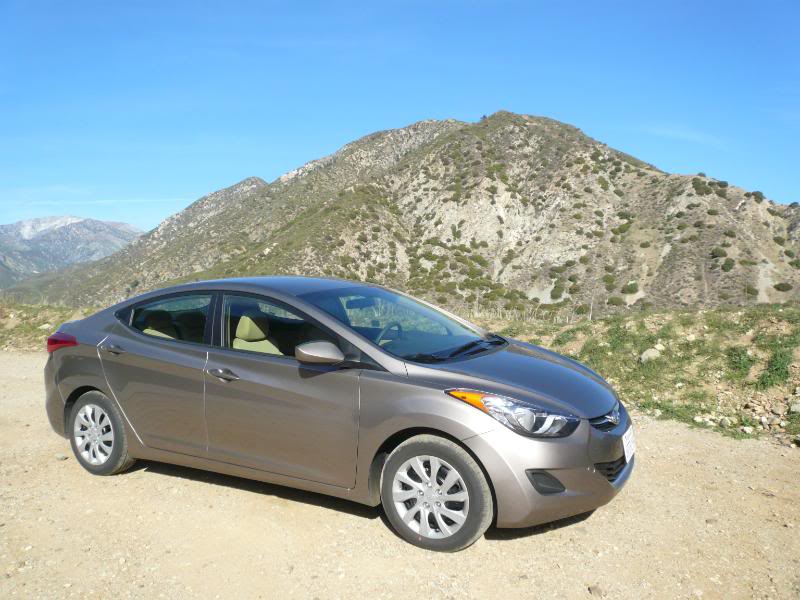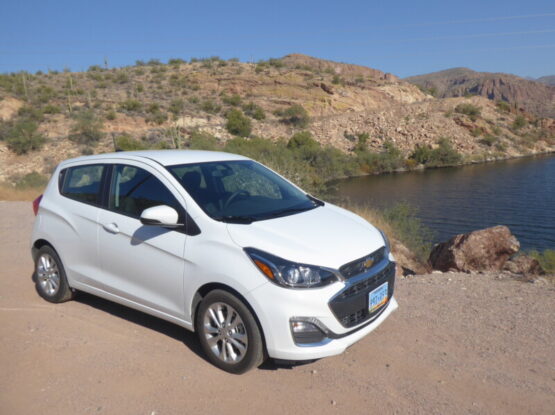


























By the time I got to sample the fourth generation Hyundai Elantra, the model had already been superceded. I concluded that although not exactly exciting, the outgoing car was perfectly agreeable and among the best in class at the time. Mindful of the new styling direction that made the fifth generation car look very much like a slightly smaller Sonata – and they are surprisingly hard to distinguish from a fleeting glance, especially of the back of the car – and also cognisant of the constant evolution evidenced in every new Hyundai’s engineering and manufacturing, I looked forward to an early opportunity to sample the new car for myself. Hyundai are almost completely conspicuous by their absence in the Hertz US fleet at least in the South West these days, but when a need to use some Swiss Frequent Flyer miles before they expired saw me making a booking at Budget, I took the chance to get a car that was not available with Hertz. Although Budget had a compound stuffed full of cars on the Saturday night when I arrived, it seemed that 99% of them were not available to rent, and my choice appeared very limited. I actually selected a slightly bigger car,but when the rear view mirror detached itself from the screen as I adjusted it, it was a case of returning to the desk to get something else, and in the interests of avoiding a Camry, the choice was an Elantra or an Elantra or an Elantra. Although these cars are sold in an array of different colours almost all of them including the test car were in the colour that Hyundai call Desert Bronze. In some lights it does have a bronze tinge to it, whereas it can also simply look grey. Be that as it may, the overall shape of the Elantra is interesting, and looks good to my eyes, so I was quite happy to take one for 24 hours to see whether the driving experience could match the sophisticated new look.










Hyundai currently only offers one engine in the Elantra, a 1.8 litre 4 cylinder unit which puts out 148 bhp, an increase of 10 bhp compared to the larger 2 litre powerplant that featured in the previous generation car. It is a smooth and refined unit, well up to the job of powering the Hyundai. Of course, it makes the car brisk rather than genuinely fast, but this is a practical family sort of car and therefore it seems entirely appropriate. Rev the engine harder and although the noise levels do increase a bit, the car is more responsive and unlikely to be embarrassed by hills unlike the Cube that I had been driving before coming to this car. Over a test distance of 320 miles, many of which were on winding canyon roads, I averaged 30.19 mpg US, which equates to 36.06 mpg Imperial, which is pretty decent. The steering is very light, as increasingly seems to be the case in so many cars these days, though I have encountered worse, and it was something to which I fairly quickly accustomed myself. I feared that this could mean that the Elantra would be no fun on the twisty canyon roads up above Los Angeles, but was pleasantly surprised, as the car took the bends better than I was expecting. I even found some new roads up in the hills behind Glendora with far more curves to test out than some of the more frequently sampled venues. On these roads, the brakes were fine, but there were a couple of occasions on the freeway when a fairly abrupt stop was called for, and I could feel the brakes lock and the ABS cut in when I would not have expected it. A central pull up handbrake features. On smoother roads, the ride was fine, but on the rougher ones, the Elantra was perhaps too firm and it transmitted more vibration and feeling of the bumps into the car than is usual for cars in this class. Apart from the challenge of collecting a car with heavy condensation on it in the dark of a rental compound and getting it out from tight spaces, I found no significant issues with visibility, despite the high tail and steeply angled rear window.





Those accustomed to the low rent interiors that used to characterise Korean cars until very recently will be in for quite a surprise when they look inside this Elantra, as it really does appear far far better than that. Some of the illusion is not quite matched by the quality of the materials, as there are still some hard plastics used, but there are plenty of nicer soft touch ones, too. No longer confronted with a sea of grey, there is a mixture of colours and textures that certainly makes the passenger compartment look quite inviting. The oatmeal coloured trim may not be the most practical, though, as the cloth seats of the test car bore a nasty stain, which would probably be quite hard to remove and the test car (admittedly a rental vehicle that some people think gives them carte blanche to abuse and not be careful with) was only a month old and had covered less than 2000 miles. Real effort has gone into designing the dashboard to make it both easy to use and interesting to look at. It is sad to report that I did notice annoying reflections from the outer trim for the centre console in the upper part of the windscreen, which were a bit of an irritant, but otherwise all was good. The main dials of speedometer and rev counter, each surrounded by a chrome ring, are clearly presented and easy to read. Bar charts show water temperature and fuel level in a small panel between the dials, which looked exactly the same as in the Nissan I had been driving the day before. The centre of the dash contains a good quality satellite radio unit mounted high up, and below it the dials for the air conditioning. Buttons to reset the trip computer and for the cruise control are on the right hand spoke of the steering wheel, and everything else is operated by the column stalks.





The swoopy styling with steeply raked rear window might lead you to fear that rear headroom has been compromised, but I was pleasantly surprised when I got into the back to try it out. My head was just clear of the roof, I guess thanks to the angle of the rear backrest and position on the seat squab, and there was a good amount of legroom with the front seat set well forward. Three adults would probably find things a little tight, but it would be manageable for shorter distances. The boot is a good regular shape and of moderate size for the class of car. Inside the cabin, odds and ends could go in the glovebox, the door pockets or a small lidded cubby at the base of the centre of the dash





Although Hyundai have done much to eradicate the feeling that they were at the budget end of motoring even in their more expensive cars, they are not totally there yet. First surprise is that the single key is a cheap and nasty old style thing with a separate fob unit for the remote central locking. I also thought that the sunvisors were particularly old school nasty hard things (though I recall even VW perpetrated this with the recently superceded Jetta). Some of the dash surfaces are still made from very hard plastics, too, but overall, the impression is that this car is well removed from its predecessors in quality terms. The fit and finish was excellent with even panel gaps and all the pieces of trim fitted together well. Two different model trims are offered: GLS and Limited. The test car was the former. Upgrading to the Limited brings leather seats, a leather wrapped steering wheel, heated seats, a sun roof and 17″ alloy wheels. Unusually, there are trim differences between the Elantra GLS Manual and Automatic. As well as the self shifting transmission, the latter has cruise control, air conditioning a tilt/telescopic steering wheel and 16″ wheels. The entry level GLS manual retails for $14,995. It costs an extra $2300 for the Automatic, and the upgrade to a Limited brings the total bill to $20.195. These are very competitive prices when compared to those of Elantra’s rivals.







The day after I returned the Elantra from whence it had come, the model was pronounced to be the American Car of the Year 2012. That is quite an accolade, and these days the winning vehicle has to be uniformly capable if it is to beat all comers. Although I’ve yet to sample many of the 2011 debutants, having now experienced the fifth generation Elantra, and found that it has a breadth of talents which go beyond the swoopy new styling, then it would seem as worthy a winner as any. As to how it fares against its competitors, well, its predecessor was near the top of the class and although some rivals have also been refreshed around the same time, Toyota’s modernisation of the rather ho-hum Corolla was largely cosmetic and Honda’s new Civic has been widely condemned as too obviously a cheapening in too many places. The Jetta has been similarly recalibrated, but sales have risen significantly, so it cannot be all bad. I’ve not sampled the latest Ford Focus or Chevy Cruze in any of the markets in which they are available, and I suspect that this pair along with the fun to drive Mazda 3 are the closest competitors. Choosing between them probably requires a careful consideration of the merits and relative strengths of each. That’s wondrous progress over the situation a few years ago when cars in this class were more likely to be selected on the basis of which was least bad rather than which is really the very best.








2012-02-14 08:59:48






































































